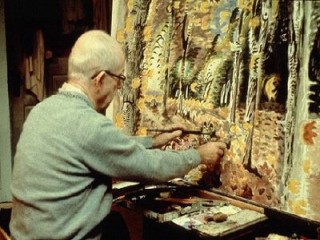
Charles Burchfield biography
Date of birth : 1893-04-09
Date of death : 1967-01-10
Birthplace : Ashtabula Harbor, Ohio, U.S.
Nationality : American
Category : Arts and Entertainment
Last modified : 2011-02-10
Credited as : Artist painter, watercolor painter,
The American painter Charles Burchfield was an expressionist nature painter, although many of his fine early works are of city or small-town subjects.
Charles Burchfield was born on April 9, 1893, in Ashtabula Harbor, OH. He grew up in the nearby town of Salem, where the family had moved after the father's death. There, on the edge of a small midwestern industrial town, Burchfield discovered nature. He walked continually in the woods and marshes around the town. He had begun drawing and painting before he entered the first grade.
Burchfield graduated from high school with a scholarship award of $120 and in a year had earned enough money to enter the Cleveland School of Art (now the Cleveland Institute of Art). He studied there for four years, supporting himself by working during vacations. His chief discovery there was Asian art, particularly the work of Hiroshige and Hokusai. When he graduated from Cleveland, the school awarded him a scholarship to the National Academy of Design in New York City. He arrived for the fall term of 1916. His trepidation about New York and the academy proved justified, and he went back to Salem at the end of November.
Back home, he continued to paint on weekends and during lunch hours. He married, moved to Buffalo, NY, to work as a wallpaper designer, and persisted as a part-time painter until 1929. He raised five children in the Buffalo suburb of Gardenville and continued living there long after he had achieved national recognition. He painted evocative pictures of small-town houses. Six O'Clock, for example, conveys a feeling of an imprisoned place remarkably like that evoked in Sherwood Anderson's stories. Burchfield also painted many straight-on industrial subjects with great feeling for their monumental strength.
Because he limited himself to scenes around his home during the 1930s, he was welcomed into the American Scene, or Regionalist, movement, though he firmly rejected any such identification. His best work, in watercolor, is distinguished by a strong sense of the life-force hidden behind the appearances of nature, pulsing in the atmosphere,
often forming a nimbus of colored light around trees, flowers, bushes, and water.
Long overlooked because he placed himself outside the art establishment of his time, Burchfield lived to see his reputation solidified by a comprehensive exhibition at the Whitney Museum of American Art in 1956. The ensuing national tour helped put an end to the financial worries that had plagued him for much of his life.
Late in his life, Burchfield created a series of dynamic free-form watercolors, again using nature as his subject matter. Working almost entirely from memory because heart trouble limited his movements, Burchfield found a new freedom and spontaneity in these later paintings. The art historian Matthew Baigell called them "some of the finest celebrations of landscape moods ever done by an American artist." As his health continued to deteriorate, Burchfield grew increasingly contemplative, often wondering at the nature of the afterlife. In 1967, while having lunch with his wife in a Buffalo restaurant, Burchfield suffered a fatal heart attack. He was 73 years old.
A small-town resident all his life, Burchfield reminded one interviewer of a backwater businessman, another of a family doctor. Essentially, Burchfield was always the boy alone in the woods, sensing the presence of cosmic forces within the forms of nature. He usually painted outdoors, face-to-face with the nature he loved. Burchfield more than any other American artist created his art out of a nature studied, loved, observed, and finally, revealed. Too often dismissed as a regionalist, Burchfield was in fact a cartographer of the human spirit. In 1997, the Columbus Museum of Art mounted a large and comprehensive exhibition of his work. The national tour that followed was designed to return Burchfield to his rightful place among the front ranks of twentieth-century American painters.
The basic work on Burchfield is John I. H. Baur, Charles Burchfield (1956), written following a major exhibition at the Whitney Museum of American Art; it is greatly enriched by Burchfield's private journal and by his conversations with the author. Burchfield is treated sympathetically in E. P. Richardson, Painting in America: The Story of 450 Years (1956), and in Alexander Eliot, Three Hundred Years of American Painting (1957). Baur's later book is The Inlander: Life and Work of Charles Burchfield, 1893-1967 (1982). Nannette V. MacIejunes and Michael D. Hall, The Paintings of Charles Burchfield: North by Midwest (1997) is an interdisciplinary study of Burchfield's oeuvre written to accompany a traveling exhibition organized by the Columbus Museum of Art.
















